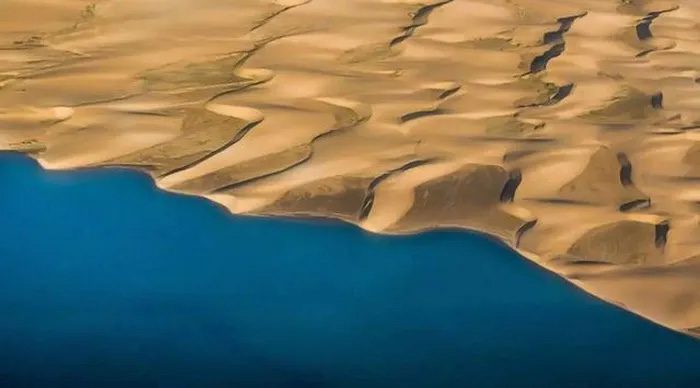If seawater can be introduced into desert areas, countries will benefit from hydroelectric projects, industrial sectors, and more. However, this idea has faced opposition from scientists.
Dreaming of Transforming the Sahara into a Sea
Sabah Al Ahmed is a vast desert region situated between Kuwait and Saudi Arabia. Until 2002, this entire desert area was covered solely with white sand, but everything began to change in 2003. More than 2,000 workers from 20 different countries, along with 29 bulldozers, 70 excavators, and 113 heavy trucks, were mobilized to Sabah Al Ahmed to undertake a super project. This involved creating a 200 km canal system to bring seawater into the desert.

The 200 km canal system in the Sabah Al Ahmed desert to bring seawater into the desert. (Photo: NBC).
Previously, the idea of digging a 600 km canal and detonating over 200 atomic bombs in the Sahara Desert to transform it into a vast sea was nearly realized in the 1980s. It is known that this concept has been researched by scientists for over 140 years.
This plan was first proposed by British engineer Donald McKenzie in 1877. According to this engineer, if a canal longer than 600 km were constructed from Cape Juby in Morocco southeast towards Mauritania, it could create an inland sea the size of Ireland. The goal of this plan was to create more fertile land and help improve the climate by making it more humid.

Several countries around the world have proposed solutions to bring seawater into deserts to improve the climate and provide water. (Photo: NBC)
They intended to use guided explosives to dig the river from northwest Africa to the center of the Sahara Desert. At the desert’s center, explosives would also be used to create deep and wide pits to channel more seawater into the wasteland.
The only scientific basis that scientists believe this project could succeed is that certain areas of the Sahara Desert, such as the El Djouf basin in Mauritania, the dry salt lakes of Tunisia, and the Qattara depression in northwest Egypt, are all situated below sea level.
In 2012, the Iranian government decided to invest $1.25 billion to pump seawater into Semnan, a city in the vast desert region. According to the plan, water from the Caspian Sea, after being desalinated, would be pumped to Semnan. This water would be used for irrigation, industrial purposes, and domestic use.

The seawater brought in will be used for irrigation, industrial purposes, and domestic use. (Photo: NBC)
Recently, the Egyptian government planned to flood the Qattara depression to benefit from hydroelectric projects. German scientists hired proposed detonating 213 atomic bombs in the heart of the desert to dig the canal. This nuclear solution was opposed by the government, and the Qattara Lake project was forgotten.
A farm in South Australia, supported by the agricultural technology company Sundrop Farms, invested $150 million to bring seawater from Spencer Gulf into the desert for vegetable cultivation. They used solar energy to desalinate seawater and planted potatoes for high yields. As a result, this farm harvested eight truckloads of potatoes daily, achieving an annual production of 15,000 tons when the system operated at full capacity.
Bringing Seawater into Deserts: Benefit or Harm?
Given the current situation, many may wonder why seawater is not directly introduced into deserts. Scientists argue that if this is implemented, it will make desert management even more challenging.
We must understand that the main cause of desertification is climate. Even if seawater is introduced, it will quickly evaporate due to the lack of vegetation, making it difficult to remedy the situation.
As seawater evaporates, a large amount of salt will be left behind, destroying the land and preventing any plants from growing.
The most crucial element in controlling deserts is not simply bringing in water. Without vegetation, water has no effect. For example, if one wants to manage a desert, it is necessary to gradually transform it into an oasis, starting with planting drought-resistant grasses, which can then develop into shrubs and trees.
Henry Sun, a microbiologist and research professor at the Desert Research Center, and Katherine Mackey, a climate scientist at the University of California, Irvine, have presented arguments opposing the introduction of water into deserts.
First, bringing seawater into the desert could destroy the local ecological conditions. Contrary to the belief that seawater will provide abundant water and rain for surrounding desert areas, this could have severe consequences. Seawater will quickly evaporate, turning a large area of land into alkaline saline soil. The soil quality in desert areas and their surroundings will be altered to the extent that not even grass can grow. Thus, this idea would bring more losses than benefits.

The idea of bringing seawater into deserts has faced opposition from scientists. (Photo: NBC)
Second, if nearly half of the Mediterranean Sea’s water and the Sahara Desert’s water were diverted, it could lead to unpredictable consequences. This would cause the tilt of the Earth to change. It could even result in the entire continent of Europe experiencing colder conditions and potentially lead to the emergence of a new ice age.
Third, using a large amount of explosives in the desert to dig canals could trigger major earthquakes and submerge the desert in seawater.
Nevertheless, the successes achieved by some projects have sparked hope for a better future if scientists can find truly effective solutions to address the risks of climate change by introducing seawater into deserts.


















































